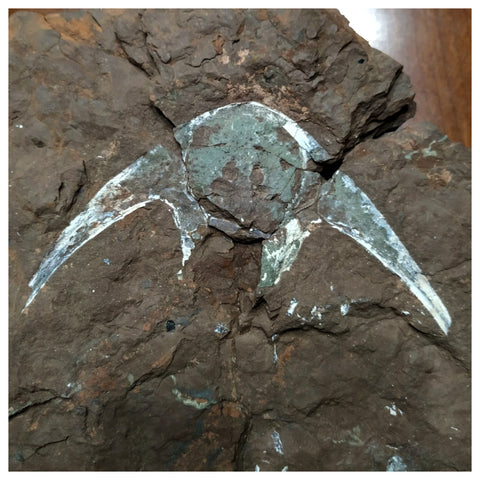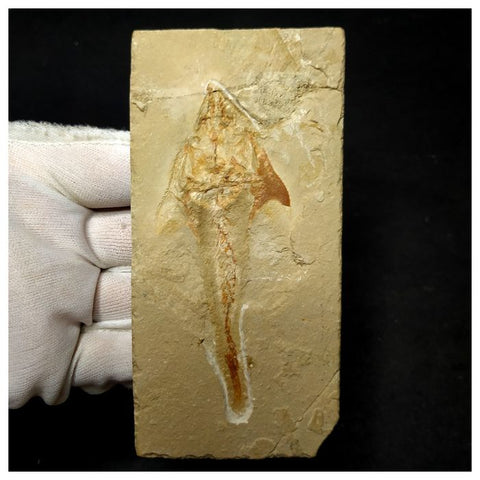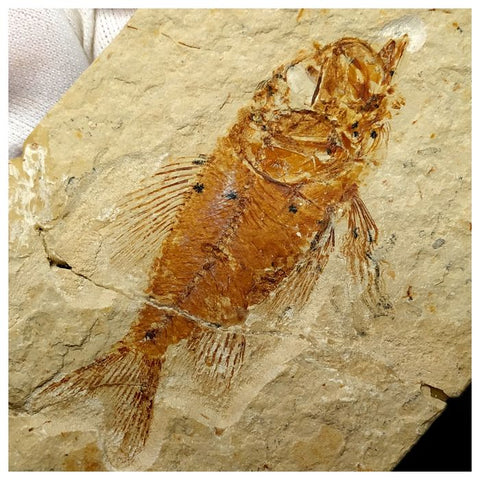Petrographic description
SAMPLE M-XX1. Petrographic description
1. Rock specimen description
The sample is a dark rock with fine grain size. A fine rim is observed on the sample, although under the petrographic study not mineralogical change was detected. Subhedral white crystals are observed of 0.5-1.0 mm length (Fig. 1).
Figure 1. The core section of the sample showing its textural features.
2. Petrographic description
The rock contains scattered crystals of clinopyroxene (augite), highly altered, mainly in the core with clean rim (Fig. 2). A mass (like a chondrule) of augite crystals appear in the center of the thin section, with the crystals altered similar to the individual grains (Fig. 3). The tabular plagioclase crystals are completely altered principally to sericite, where sometimes calcite appears together.
Brown-pleochroic euhedral to subhedral hornblende crystals are abundant (Figs. 2-4). Chlorite is also abundant, whereas barite and calcite appear in altered zones. Calcite fills fractures; this and the other secondary minerals denote the alteration suffered by the sample. Magnetite,
titanomagnetite and ilmenite are the metallic minerals of the sample. Apatite and zircon appears as accessory phases. Hornblende represents the 25 % of mineralogical composition of the sample; the altered plagioclase is around the 60 %, whereas augite phenocrysts contents are scarcer and
close to 5 %. In the section, relict igneous texture is preserved and the rock could be a highly altered diabase dike.
Figure 2. Photomicrograph showing an augite crystal highly altered in the core and a clean rim. Tabular brown hornblendes appear in a mass of highly altered plagioclase. Up parallel and down crossed nicols. The wide of the picture is 2.6 mm.
Figure 3. Photomicrograph showing a mass (chondrule) of augite crystals highly altered in the cores and clean rims. The crystals have a dirty appearance. Tabular brown hornblendes are in a mass of highly altered plagioclase. Yellow, slightly pleochroic chlorites are observed. Up parallel and down crossed nicols. The wide
of the picture is 4.8 mm.
Figure 4. . Photomicrograph showing brown hornblende crystals in a mass of highly sericitized plagioclase with very fine grain size. Note the abundance of opaque minerals and the presence of chlorite in the microphotographs. Up parallel and down crossed nicols. The wide of the picture is 1.3 mm.
Figure 5. Scanning electron microscopy (backscattered electron mode) images showing the abundance of plagioclase and the presence of augite as phenocrystals but also in the matrix. The brilliant crystals in the
center of the second image are barite.
Figure 6. Scanning electron microscopy (backscattered electron mode) images showing the abundance of albite plagioclase and the presence of euhedral amphibole crystals; the amphibole is slightly altered to calcite. The second image displays a highly altered augite crystal. Important to note is the formation of
pigeonite in the core together with albite and potassium feldspar.
The scanning electron microscopy images and the energy dispersive spectroscopy analyses indicate that the pyroxenes have augite composition in the rim. This border has moderate content of Al 0.37 apfu (atoms per formula unit) and Ca up to 0.85-0.90 apfu. In the altered core, pigeonite compositions were determined, appearing together with plagioclase and potassium feldspar.
These pigeonite crystals have low values of Ca 0.20 apfu and high Al 0.90 apfu. In the pyroxene chondrule presents a variable composition, with high Al 0.40-0.60 apfu and variable Ca 0.46-0.70 apfu contents.
The plagioclase has high albite composition XAb= 0.80-0.90.
Fe-Ti oxides are common in the matrix, a low Cr contents are observed.
In the alteration zone (Figure 5B) the close relation between calcite and barite is observed.
The following Table contains the calculated compositions, which reveal that amphiboles are kaersutite.
Si Ti Al Fe2+ Mg Ca Na K Mg#
5.44 0.76 2.54 1.20 2.75 2.11 1.18 0.24 0.70
5.43 0.77 2.59 1.17 2.71 2.11 1.19 0.21 0.70
No major chemical differences in between core and rim were determined.
The mineral association and composition and the sample texture indicate that probably this rock is
an igneous dyke, probably a basalt or diabase (Le Maître et al., 2005).
Mineralogy and textural properties of samples were studied on (30m-thick) polished thin sections using transmitted and reflected light microscopy at LPA (UA) and UGR.
Photomicrographs were performed by using:
o Petrographic microscope: ZEISS Assioskop (LPA-UA).
o Digital camera: Photometrics CoolSNAPcf
o Image capture Software: RS ImageTM v.1.8.6
Samples (polished thin-sections) also were studied under scanning electron microscope (Research Technical Services – UA). Minerals were located and identified using BSE mode on Hitachi S3000N SEM coupled with an X-ray detector Bruker XFlash 3001 for microanalysis (EDS) and mapping. Semi-quantitative EDS X-ray microanalysis was performed using EDS spot analysis with acquisition time 60s and maximum process time to achieve best resolution of peaks in spectra.
ANNEX II. REFERENCES
Le Maître, R.W. (Editor), Streckeisen, A., Zanettin, B., Le Bas, M. J., Bonin, B., Bateman, P., Bellieni, G., Dudek, A., Efremova, S., Keller, J., Lameyre, J., Sabine, P.A., Schmid, R., Sørensen, H. & Woolley, A.R. 2005. Igneous Rocks: A Classification and Glossary of Terms: Recommendations of the International Union of Geological Sciences Subcommission on the Systematics of Igneous Rocks. Cambridge University Press. Second Edition, revised, 236 p. Cambridge, UK.






















































